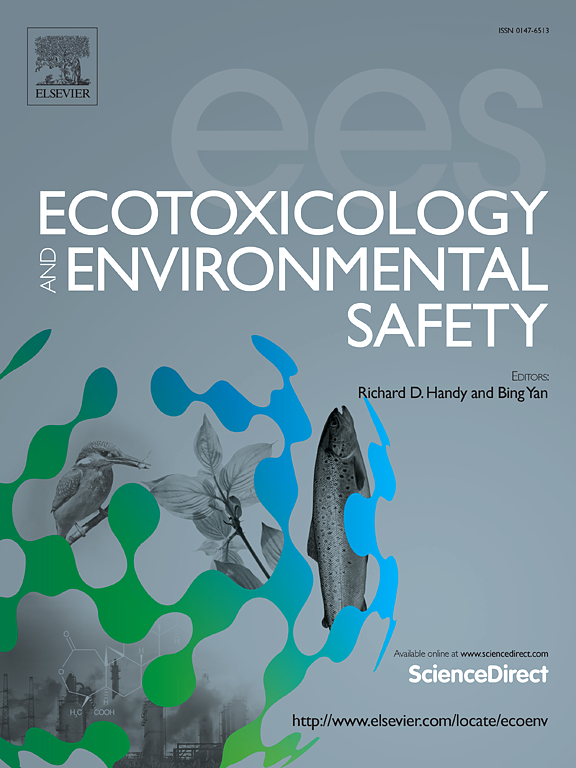The involvement of nicotinate and nicotinamide metabolism pathway in attenuating benzene-induced mouse hematotoxicity
IF 6.2
2区 环境科学与生态学
Q1 ENVIRONMENTAL SCIENCES
引用次数: 0
Abstract
Benzene exposure has been linked to various adverse health effects. However, the effective strategy for prevention or treatment of benzene-induced hematotoxicity remains unsolved. We previously administrated hepatocyte-specific deletion of Ppp2r1a gene (encoding PP2A Aα subunit) mice with benzene via inhalation for 28 days, and found homozygote (HO) mice exhibited alleviative hematotoxicity compared with wild type (WT) mice. Here, we integrate untargeted metabolomics and transcriptomics data to identify the key metabolic pathways and metabolites attenuating benzene-induced hematotoxicity. Metabolomics analysis revealed the perturbation of nicotinate and nicotinamide metabolism, as well as taurine and hypotaurine metabolism pathways, were implicated in regulating benzene-induced hematotoxicity. Meanwhile, transcriptome analysis showed that immune-, inflammation-, and metabolism-related pathways were obviously disturbed in WT mice groups upon benzene exposure, while sirtuin signaling pathway, associated with nicotinate and nicotinamide metabolism, was activated in HO mice groups. Notably, combined metabolomics and transcriptomics analysis further confirmed the involvement of nicotinate and nicotinamide metabolism, taurine and hypotaurine metabolism pathways in relieving benzene-induced hematotoxicity. Specific metabolites, including 1-methylnicotinamide (MNA), nicotinamide (NA), β-nicotinamide mononucleotides (NMN), and taurine were identified as the potential metabolites alleviating benzene-induced adverse effects. In vitro experiments demonstrated the protective effect of MNA and NA against 1,4-benzoquinone (1,4-BQ)-caused cytotoxicity in HL-60 cells. In vivo, MNA supplementation in drinking water could effectively restore the decline in white blood cell (WBC), lymphocyte (LYMPH), and reticulocyte (RET) counts, also mitigate oxidative damage and genotoxicity in response to benzene exposure. These observations highlight the potential of MNA supplementation as a strategy for preventing benzene-caused hematotoxicity.
烟酸和烟酰胺代谢途径参与减轻苯诱导的小鼠血液毒性
接触苯与各种不良健康影响有关。然而,预防或治疗苯诱导的血液毒性的有效策略仍未解决。此前,我们曾给肝细胞特异性缺失 Ppp2r1a 基因(编码 PP2A Aα 亚基)的小鼠吸入苯 28 天,发现与野生型(WT)小鼠相比,同基因型(HO)小鼠的血液毒性有所减轻。在这里,我们整合了非靶向代谢组学和转录组学数据,以确定减轻苯诱导的血液毒性的关键代谢途径和代谢物。代谢组学分析表明,烟酸和烟酰胺代谢以及牛磺酸和低牛磺酸代谢途径的扰动与调节苯诱导的血液毒性有关。同时,转录组分析表明,苯暴露后,WT小鼠组的免疫、炎症和代谢相关通路明显紊乱,而HO小鼠组与烟酸和烟酰胺代谢相关的sirtuin信号通路被激活。值得注意的是,代谢组学和转录组学的联合分析进一步证实了烟酸和烟酰胺代谢、牛磺酸和低牛磺酸代谢途径参与缓解苯诱导的血液毒性。包括 1-甲基烟酰胺(MNA)、烟酰胺(NA)、β-烟酰胺单核苷酸(NMN)和牛磺酸在内的特定代谢物被确定为缓解苯诱导的不良反应的潜在代谢物。体外实验证明,MNA 和 NA 对 1,4- 苯醌(1,4-BQ)引起的 HL-60 细胞细胞毒性具有保护作用。在体内,在饮用水中补充 MNA 能有效恢复白细胞(WBC)、淋巴细胞(LYMPH)和网状细胞(RET)数量的下降,还能减轻苯暴露引起的氧化损伤和遗传毒性。这些观察结果凸显了补充 MNA 作为一种预防苯引起的血液毒性的策略的潜力。
本文章由计算机程序翻译,如有差异,请以英文原文为准。
求助全文
约1分钟内获得全文
求助全文
来源期刊
CiteScore
12.10
自引率
5.90%
发文量
1234
审稿时长
88 days
期刊介绍:
Ecotoxicology and Environmental Safety is a multi-disciplinary journal that focuses on understanding the exposure and effects of environmental contamination on organisms including human health. The scope of the journal covers three main themes. The topics within these themes, indicated below, include (but are not limited to) the following: Ecotoxicology、Environmental Chemistry、Environmental Safety etc.
文献相关原料
公司名称
产品信息
阿拉丁
benzene

 求助内容:
求助内容: 应助结果提醒方式:
应助结果提醒方式:


